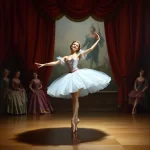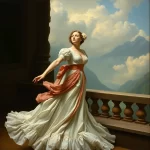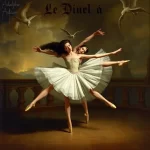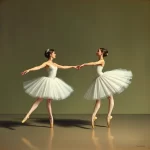Ballet: Paquita (Ludwig Minkus, 1846)

Introduction
Ballet, an art form that combines music, dance, and storytelling, has produced numerous masterpieces over the centuries. One such gem is “Paquita,” a ballet composed by Ludwig Minkus in 1846. This ballet, choreographed by Joseph Mazilier, premiered at the Paris Opera Ballet and has since become a staple in the classical ballet repertoire. “Paquita” tells the story of a young Spanish girl who discovers her noble heritage and finds love amidst a backdrop of political intrigue and adventure.
Historical Background
Creation and Development
“Paquita” was created during a period of significant artistic and social change in Europe. The mid-19th century was a time when Romanticism was at its peak, influencing literature, music, and the arts. Ballets of this era often featured exotic locales, dramatic plots, and supernatural elements. “Paquita” was inspired by the Spanish setting and the themes of love and identity, which were popular in Romantic literature and folklore.
The collaboration between choreographer Joseph Mazilier and composer Ludwig Minkus was crucial to the ballet’s creation. Mazilier, a prominent figure in the Paris Opera Ballet, brought his expertise in dramatic storytelling and innovative choreography. Minkus, known for his melodic and expressive compositions, provided a score that perfectly complemented the ballet’s narrative and emotional depth.
Premiere and Reception
“Paquita” premiered on April 1, 1846, at the Paris Opera Ballet. The initial reception was overwhelmingly positive, with critics and audiences praising the ballet’s engaging story, beautiful music, and captivating choreography. The ballet quickly gained popularity and was performed in various European cities. Notable early performances included revivals in St. Petersburg and Moscow, where it became a favorite in the Russian ballet repertoire.
Synopsis of the Ballet
Act I Summary
The ballet opens in a picturesque Spanish village where Paquita, a young gypsy girl, lives. She is unaware of her noble birth and has been raised by gypsies. The village is bustling with preparations for a festival, and Paquita catches the eye of Lucien d’Hervilly, a French officer. Despite their different social standings, they are immediately drawn to each other. However, the local governor, Don Lopez, has sinister plans to marry Paquita off to a wealthy but cruel nobleman. The act ends with Paquita and Lucien vowing to find a way to be together.
Act II Summary
In the second act, Paquita discovers a locket that reveals her true identity as the daughter of a noble family. With this newfound knowledge, she seeks the help of Lucien and his comrades to thwart Don Lopez’s plans. The act is filled with dramatic confrontations, daring escapes, and moments of tender romance. The climax comes when Paquita and Lucien confront Don Lopez, exposing his treachery and securing Paquita’s rightful place in society.
Finale
The ballet concludes with a grand celebration of Paquita’s noble heritage and her union with Lucien. The villagers and nobility come together to celebrate their love and the triumph of justice. The finale is marked by elaborate dance sequences, including the famous Grand Pas Classique, showcasing the technical prowess and artistry of the dancers. The ballet ends on a joyous note, with Paquita and Lucien looking forward to a bright future together.
Musical Composition
Composer’s Role
Ludwig Minkus, an Austrian composer, played a pivotal role in the success of “Paquita.” Known for his work in ballet music, Minkus created a score that is both melodically rich and rhythmically dynamic. His music for “Paquita” includes a variety of styles, from lively Spanish dances to romantic pas de deux, enhancing the narrative and emotional depth of the ballet. Notable pieces within the score include the “Mazurka des Enfants” and the “Grand Pas Classique,” which have become iconic in the ballet world.
Musical Themes and Motifs
The music of “Paquita” is characterized by recurring themes and motifs that reflect the characters and their emotions. For example, Paquita’s theme is light and playful, capturing her youthful spirit and innocence. In contrast, the music associated with Don Lopez is darker and more menacing, highlighting his villainous nature. These musical elements not only enhance the storytelling but also provide dancers with cues for their movements and expressions.
Famous Recordings and Performances
Over the years, “Paquita” has been recorded and performed by numerous prestigious ballet companies. Some of the most iconic recordings include those by the Bolshoi Ballet and the Mariinsky Ballet, both of which have contributed to the ballet’s enduring popularity. These performances are celebrated for their technical excellence and faithful interpretation of Minkus’s score.
Choreography and Dance
Choreographer’s Vision
Joseph Mazilier’s vision for “Paquita” was to create a ballet that combined dramatic storytelling with innovative choreography. His approach emphasized character development and emotional expression through dance. Mazilier introduced several innovations in the choreography, including intricate footwork and complex partnering sequences, which have become hallmarks of the ballet.
Signature Dance Numbers
“Paquita” features several signature dance numbers that are celebrated for their technical brilliance and artistic beauty. The “Grand Pas Classique,” a highlight of the ballet, is a showcase of virtuosity and elegance, featuring solos, duets, and ensemble dances. Another notable number is the “Pas de Trois,” which highlights the skills of three principal dancers in a series of intricate and synchronized movements. These dance numbers not only reflect the story’s themes but also provide opportunities for dancers to display their talents.
Notable Interpretations
Over the years, different productions of “Paquita” have offered unique interpretations of the choreography. Some have emphasized the ballet’s romantic elements, while others have focused on its dramatic and adventurous aspects. Notable interpretations include those by Marius Petipa, who revised the ballet for the Imperial Ballet in St. Petersburg, adding new dances and enhancing the overall production. Contemporary choreographers have also reimagined “Paquita,” incorporating modern techniques and styles while staying true to its classical roots.
Characters and Roles
Main Characters
- Paquita: The protagonist, a spirited and courageous young woman who discovers her noble heritage.
- Lucien d’Hervilly: A French officer who falls in love with Paquita and helps her uncover her true identity.
- Don Lopez: The antagonist, a corrupt governor who seeks to marry Paquita off for his own gain.
Supporting Characters
- Inigo: A gypsy leader who raised Paquita and supports her quest for justice.
- Serafina: A noblewoman who befriends Paquita and aids her in her journey.
- Lucien’s Comrades: Fellow officers who assist Lucien and Paquita in their efforts to thwart Don Lopez.
Famous Dancers
Many renowned dancers have portrayed the roles in “Paquita” over the years. Notable performers include Anna Pavlova, who brought grace and elegance to the role of Paquita, and Rudolf Nureyev, whose portrayal of Lucien d’Hervilly was celebrated for its technical brilliance and emotional depth. These dancers have left a lasting legacy, inspiring future generations to take on these iconic roles.
Cultural and Artistic Impact
Influence on Ballet and Dance
“Paquita” has had a significant influence on the world of ballet and dance. Its innovative choreography and compelling narrative have inspired other works and choreographers. The ballet’s emphasis on character development and storytelling through dance has become a model for subsequent productions. Additionally, the technical demands of “Paquita” have pushed dancers to new heights of skill and artistry.
Cultural Significance
The cultural significance of “Paquita” extends beyond the ballet world. Its themes of love, identity, and justice resonate with audiences across different cultures and time periods. The ballet has been referenced in literature, film, and other media, highlighting its enduring appeal. Adaptations of “Paquita” have appeared in various forms, including theater productions and modern dance interpretations, showcasing its versatility and relevance.
Legacy and Revivals
“Paquita” continues to be performed and celebrated today, with major revivals and reinterpretations keeping the ballet alive for new audiences. Companies such as the Bolshoi Ballet and the Mariinsky Ballet regularly include “Paquita” in their repertoires, ensuring its legacy endures. Modern adaptations have introduced fresh perspectives while honoring the ballet’s classical roots, demonstrating its timeless appeal.
Iconic Productions
Historic Productions
Some of the most famous historical productions of “Paquita” include the 1881 revival by Marius Petipa for the Imperial Ballet in St. Petersburg. This production introduced new dances and enhanced the overall choreography, solidifying “Paquita” as a cornerstone of the classical ballet repertoire. Key figures involved in these historic productions include legendary dancers such as Mathilde Kschessinska and Enrico Cecchetti, whose performances set new standards for excellence.
Contemporary Productions
Recent productions of “Paquita” have brought new interpretations and innovations to the ballet. Companies like the American Ballet Theatre and the Royal Ballet have staged contemporary versions that incorporate modern techniques and styles while staying true to the original spirit of the ballet. These productions often feature updated set and costume designs, adding a fresh visual appeal to the timeless story.
Production Design
The production design of “Paquita” plays a crucial role in bringing the story to life. Set designs often feature picturesque Spanish villages, grand ballrooms, and lush landscapes, creating a vivid backdrop for the action. Costume designs reflect the characters’ social standings and personalities, with elaborate gowns for the nobility and colorful, rustic attire for the gypsies. Lighting design enhances the mood and atmosphere, highlighting key moments and adding depth to the overall production.
Critical Reception and Reviews
Initial Critical Response
At the time of its premiere, “Paquita” received glowing reviews from critics and audiences alike. The ballet was praised for its engaging story, beautiful music, and innovative choreography. Critics highlighted the performances of the lead dancers, noting their technical prowess and emotional depth. The success of “Paquita” at its premiere set the stage for its enduring popularity.
Modern Reviews
Contemporary critics continue to celebrate “Paquita” for its timeless appeal and artistic excellence. Reviews often highlight the ballet’s intricate choreography, expressive music, and compelling narrative. Modern audiences appreciate the ballet’s ability to convey universal themes of love and identity while showcasing the technical skills of the dancers. The enduring relevance of “Paquita” is a testament to its status as a classic in the world of ballet.
Fun Facts and Trivia
Behind-the-Scenes Stories
One interesting anecdote from the production of “Paquita” involves the discovery of the original score. For many years, parts of Minkus’s music were thought to be lost, but a complete version was eventually found in the archives of the Mariinsky Theatre. This discovery allowed for more authentic revivals of the ballet, preserving Minkus’s original vision.
Notable Performers
Over the years, many famous dancers have been associated with “Paquita.” In addition to Anna Pavlova and Rudolf Nureyev, other notable performers include Margot Fonteyn, who brought grace and elegance to the role of Paquita, and Mikhail Baryshnikov, whose portrayal of Lucien d’Hervilly was celebrated for its technical brilliance and emotional depth.
Trivia
- “Paquita” was one of the first ballets to feature a female protagonist who discovers her own noble heritage, a theme that would become popular in later works.
- The “Grand Pas Classique” from “Paquita” is often performed as a standalone piece in ballet galas and competitions, showcasing its enduring popularity.
- The ballet’s Spanish setting and themes were inspired by the Romantic fascination with exotic locales and cultures, reflecting the broader artistic trends of the time.
Conclusion
Summary of the Ballet’s Importance
“Paquita” holds a significant place in the world of ballet, combining beautiful music, innovative choreography, and a compelling narrative. Its themes of love, identity, and justice resonate with audiences across different cultures and time periods. The ballet’s technical demands have pushed dancers to new heights of skill and artistry, making it a cornerstone of the classical ballet repertoire.
Final Thoughts
Reflecting on “Paquita,” it is clear why this ballet has endured for over a century. Its timeless story, captivating music, and intricate choreography continue to inspire and entertain audiences around the world. Whether you are a seasoned ballet enthusiast or a newcomer to the art form, “Paquita” offers a rich and rewarding experience that showcases the best of classical ballet. We encourage readers to watch a performance or listen to the score to fully appreciate the beauty and artistry of this remarkable ballet.
FAQ
What is the central theme of this ballet?
The central theme of “Paquita” is the discovery of one’s true identity and the triumph of love and justice over adversity.
Who are the main characters in this ballet?
The main characters are Paquita, a young gypsy girl who discovers her noble heritage; Lucien d’Hervilly, a French officer who falls in love with Paquita; and Don Lopez, the corrupt governor who seeks to marry Paquita off for his own gain.
What is the most famous dance number in this ballet?
The most famous dance number in “Paquita” is the “Grand Pas Classique,” a showcase of virtuosity and elegance featuring solos, duets, and ensemble dances.
How long does a typical performance of this ballet last?
A typical performance of “Paquita” lasts approximately two hours, including intermissions.
Are there any modern adaptations of this ballet?
Yes, there are modern adaptations of “Paquita” that incorporate contemporary techniques and styles while staying true to the original spirit of the ballet. These adaptations often feature updated set and costume designs, adding a fresh visual appeal to the timeless story.
Why is this ballet considered important in the history of dance?
“Paquita” is considered important in the history of dance because of its innovative choreography, beautiful music, and compelling narrative. It has influenced other works and choreographers, pushed dancers to new heights of skill and artistry, and remains a cornerstone of the classical ballet repertoire.





